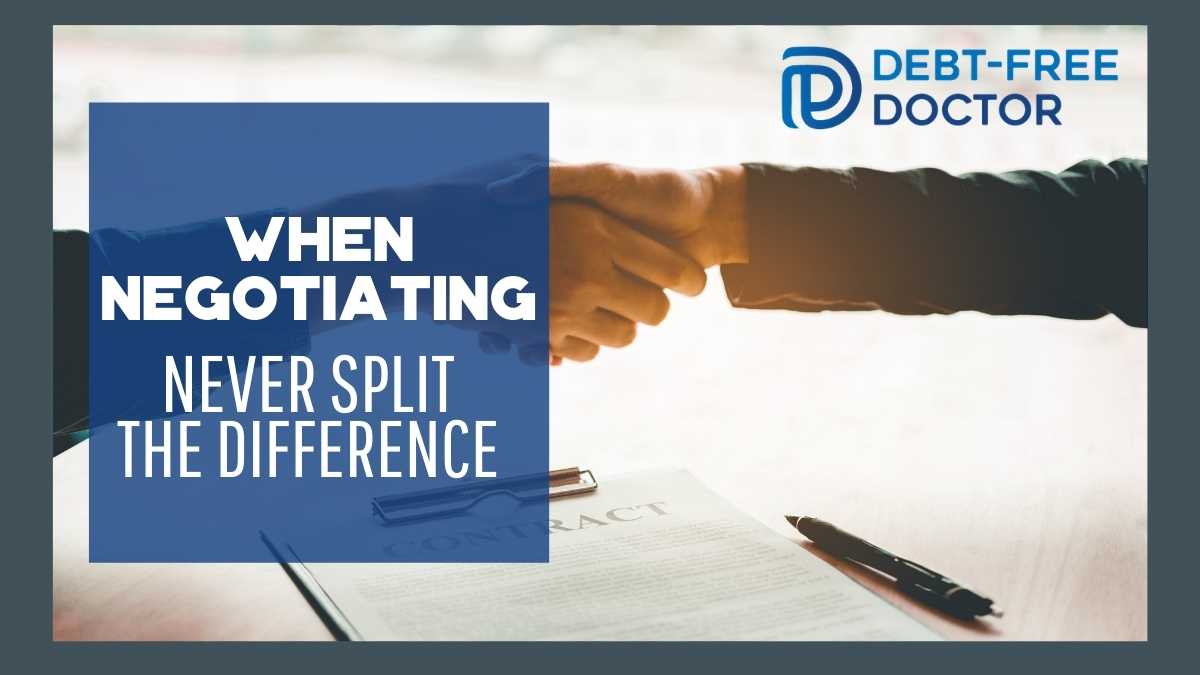Chris Voss Never Split The Difference
There’s something about terrorists, Navy Seals, hostage negotiations and drug cartels that’s always peaked my interest. So when I recently heard former FBI hostage negotiator Chris Voss discuss his book, Never Split The Difference on the Entreleadership podcast, I was immediately fascinated.
When you think about it, we’re negotiating with people on a daily basis. Whether it’s with your kids, the barista at Starbucks, a car salesman, your employees or spouse, life is a constant negotiation.
Unfortunately, most of the advice we’ve been given about negotiating is dead wrong.
Voss’s book is all about how you can gain the competitive edge in any discussion. It builds a foundation for negotiation on the basis of understanding the other party through empathy and active listening skills.
- Are you tired of telling your kids to do something that falls on deaf ears?
- Are you fed up with being taken advantage of whenever you’re purchasing a car, house or other large ticket item?
- Do you want a raise but not sure how to approach your employer?
If so, read on!
Chris Voss Never Split The Difference – Google Talk
Google invited Chris to speak to a handful of their employees regarding negotiations.
It’s a lengthy video (50 min) but worth watching.
What Is A Negotiation?
A negotiation is nothing more than an opportunity to share information.
In the Chris Voss Never Split The Difference book, he states that each negotiation should be approached through a commitment to empathy.
We also learned, from Dr. Robert Cialdini’s book: Influence – The Psychology of Persuasion, how important showing empathy through active listening was.
People want two main things: To be HEARD and UNDERSTOOD
The goals should be:
Listen intensely → demonstrate empathy + show a sincere desire to better understand what the other side is experiencing
In other words, put yourself in the other person’s shoes, whether you agree with them or not.
What only matters is that you can listen intently, and then communicate in a way that demonstrates that you’re hearing what matters to them.
Negotiating With Patients

If you’re a doctor, more than likely you haven’t received negotiating skills when learning how to ethically persuade patients to accept treatment recommendations.
Remember, a negotiation is nothing more than sharing information.
Your job is to provide knowledge and treatment to move people towards their best interests & not convince them to buy something they don’t need.
Convincing someone to say “Yes” to something they don’t need is called Coercion or Intimidation. When we talk about when we influence and persuade people to say “yes” to treatment recommendations, we’re talking about something completely different.
Your main job is getting them healthy and not sales.
Once you become a better negotiator, more patients will tend to follow your recommendations making it a win-win scenario for you both.
Don’t Miss Any Updates. Each week I’ll send you advice on how to reach financial independence with passive income from real estate.
Sign up for my newsletterOld School Negotiating
One thing that the COVID-19 pandemic taught us was this:
People are emotional and irrational creatures.
Actually, it’s what makes us humans after all. It’s for this reason that Voss’s book teaches why old school negotiating tactics don’t work that well because they ignore WHO is actually doing the negotiating….humans!
Remember the key to successfully negotiating is showing empathy to the other side.
Do You Hear What I Hear?
Do you remember the two main things a person wants?
To be HEARD and UNDERSTOOD
Listening is the cheapest yet most effective way to help people get what they want. How about that?
The best solution is FREE!

It’s for this reason that all negotiations should start off with “active listening”.
One of the first things I do when I see a patient for a consultation is to let them talk while I actively listen.
It doesn’t take long to notice they yearn to be understood with whatever problem they’re dealing with.
You’re never going to become a great negotiator until you become a master active listener.
By listening intensely, a negotiator demonstrates empathy and shows a sincere desire to understand what the other person is experiencing.
Unfortunately, this is completely different than what you’re used to doing…. “passive listening” — which is hearing only what you want to hear and filtering out the rest.
Be A Mirror

Mirroring (essentially imitation) works magic by creating trust and trust wins negotiations.
Mirroring in nothing more than repeating back what the other person is saying. This is done by using the last 3 or 4 words of what the other person said.
Here’s an example. If the other person says, “I can’t believe that cars cost so much money” then you should reply with “Yes, it’s amazing that now cars cost so much money…” and then continue with what point you want to get across.
Mirroring allows rapport to be built by using the same expressions or words they’re using. By doing this, a connection or common ground is made to let the other person know that not only are you hearing them loud and clear but you are also similar to them.
Mirroring works because humans fear what’s different and are drawn to what’s similar.
Don’t Feel Their Pain, Label It
Mirroring allows the person to be heard. So what’s next?
They want to be understood, right?
This is accomplished with what Voss calls “tactical empathy”.
Tactical empathy is understanding the feelings and mindset of a person and also hearing what is behind those feelings so you can increase your influence in all the time that follows.”
In the Chris Voss Never Split the Difference book, tactical empathy is accomplished by “labeling“. This is a way of validating someone’s emotion by acknowledging it.
Give someone’s emotion a name and you show you identify with how that person feels.
Labeling has a special advantage when your counterpart is tense. Most patients we see for the first time are TENSE..
Once you’ve spotted an emotion you want to highlight, the next step is to label it ALOUD.
Labels almost always begin with roughly the same words:
- It seems like…
- It looks like…
- It sounds like…
The last rule of labeling is SILENCE.
Once you’ve thrown out a label, be quiet and listen.
For example, if you notice a patient is having second thoughts about undergoing a procedure due to finances, label it with, “It seems like…money is an issue to you…” and them let them fill in the rest.
Labels help to uncover and ID the primary emotion driving almost all of your counterpart’s behavior, the emotion that, once acknowledged, seems to miraculously solve everything else.
Join the Passive Investors CircleTwo Words that Transform Any Negotiation
So far we’ve learned that in order to be successful with negotiating, we must:
- actively listen
- employ tactical empathy
- use mirroring and labeling
The reason we do this is to get the other person to say the two magical words during a negotiation: “that’s right”
Before you convince people to see what you’re trying to accomplish, you have to say the things to them that’ll get them to say, “that’s right”.
Unfortunately, too many of us want to hear a “you’re right” instead.
Voss states that when somebody says, ‘You’re right,’ what they’re really saying to you is, ‘Please, shut up. Stop talking. I can’t take it anymore”. “Either they like you — or they have to act like they like you,” so they are being polite by wrapping up the conversation in a way that indicates agreement.
When your counterpart says “that’s right”, they feel like a mutual understanding has been reached and it allows you both to move forward.
Instead of focusing on hearing “you’re right”, strive to get a “that’s right” from your counterpart.
In essence, they’re crediting you with seeing things their way which helps to transform the negotiation environment.
Using Calibrated Questions For The Win
The next step in the Chris Voss Never Split The Difference book is to use what Voss calls “calibrated questions”.
These are open-ended “how” and “what” questions for when you inevitably hear something you don’t like.
- “How am I supposed to do that?” or
- “What are we really trying to accomplish here?”
These types of questions prompts for a longer answer.
Whenever we train staff members to answer the phone, they typically ask more closed-ended questions (where a “yes” or “no” response is given).
For instance, if someone wants to cancel an appointment, many times they’ll ask, “Do you want to reschedule?” instead of “WHEN would you like to reschedule?”
See the difference?
Using open-ended “how” and “what” questions help put the other person to work so they can give you an advantage during the negotiating process.
The 7-38-55% Rule
The 7–38–55 rule says:
- 7% of a message is based on words
- 38% comes from tone of voice
- 55% from body language and facial expressions
Voss teaches that body language and tone of voice – not words – are our most powerful assessment tools. That’s why Voss stated that he’d often fly great distances to meet someone face-to-face, even when he could have said what he needed to say over the phone.
When you use this rule, pay very close attention to tone and body language to make sure they match up with the literal meaning of the words.
When you detect a mismatch, use labels to discover why there is disagreement and show the other party you are actively listening and empathizing with them.
Don’t Miss Any Updates. Each week I’ll send you advice on how to reach financial independence with passive income from real estate.
Sign up for my newsletterSurprise With A Gift
Whenever you surprise someone with an unsuspecting gift, you are able to introduce a dynamic called reciprocity.

We’re deeply wired to be reciprocal. It’s for this reason that people are more likely to say “Yes” to your request when you first give them a small, unexpected, meaningful gift.
Basically, “If you’ll scratch my back, I’ll scratch yours.”
Have you ever bought someone’s lunch? What do they usually say afterwards? Is it something like, “You don’t have to do that, let me buy yours next time.”
That’s the principle of Reciprocity in action.
Simply put, people are obliged to give back to others the form of a behavior, gift, or service that they have received first.
It’s Now Up To You
Now you know that the key to a successful negotiation involves understanding that the emotions of the other person play a much bigger role than facts and logic.
Remember, you should focus on giving folks what they want (to be heard and understood) in order to diffuse any situation.
I recommend picking up Chris’s book if you’re looking to better your everyday negotiation skills whether it be negotiating your salary, obtain hotel/airline upgrades or trying to get out of that darn speeding ticket!


